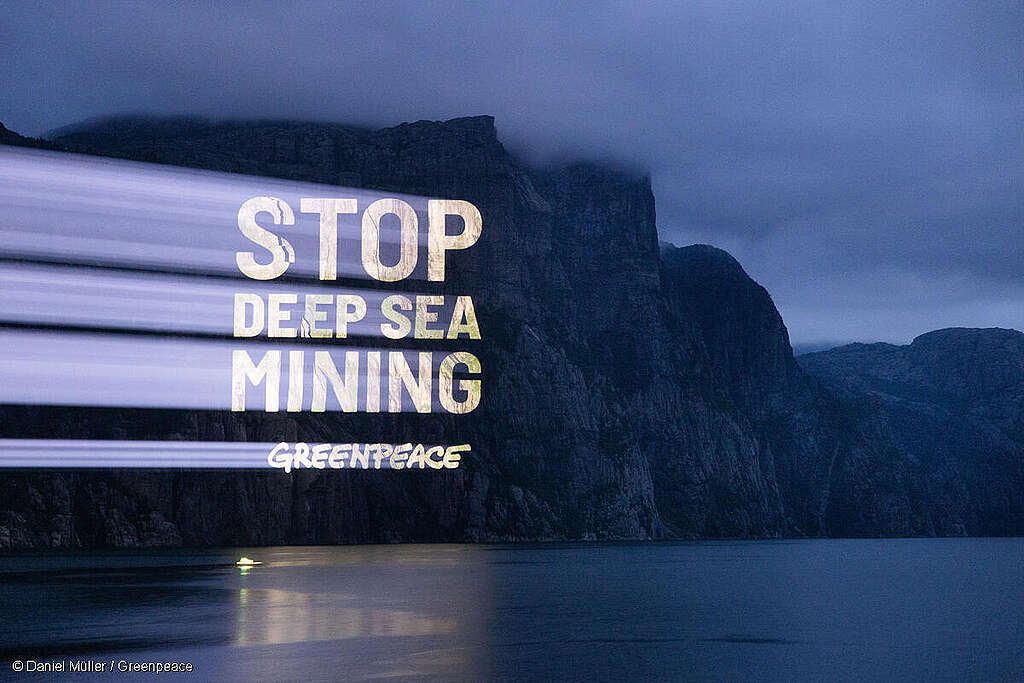
PETITION: Stop Deep Sea Mining
An emerging new industry could destroy this fragile and unique deep sea environment before we truly understand its importance.
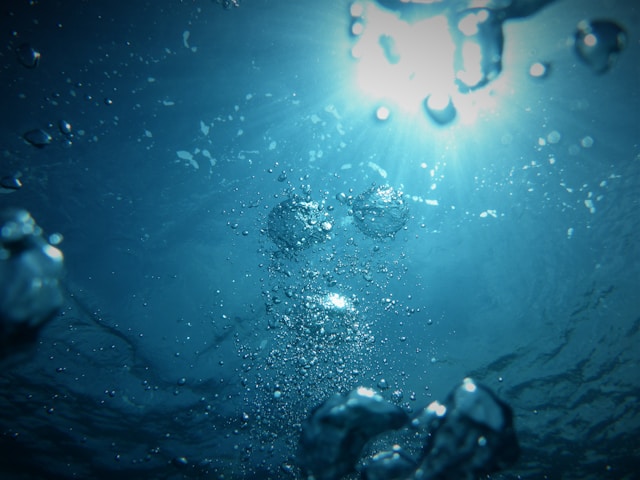
Nick Young 26 July 2024 / Greenpeace Scientists have found a source of ‘dark oxygen’ 4,000 meters below the surface of the Pacific in the target zone for deep sea mining. The discovery could have far-reaching implications for science and the wannabe deep sea mining industry. It’s often said that we know more about the surface of the moon than we do about the deep ocean. This new discovery of dark oxygen shows how true that is, and underlines the need to stop a new deep sea mining industry from targeting its source.
What scientists mean by ‘dark oxygen’ is that – in the total darkness of the very deep ocean – around 4,000 meters below the surface of the Pacific Ocean – oxygen is being produced – in the dark.
It’s previously been thought that oxygen on Earth is produced on land and at the surface of the ocean, where sunlight makes plant photosynthesis possible.
Plants on land are the biggest producers of oxygen, but marine algae and phytoplankton also produce it. These microscopic organisms perform photosynthesis in the ocean, which covers about 70% of the Earth’s surface.
Blue-green algae – or cyanobacteria – are some of the oldest organisms on Earth and can also produce oxygen. They were among the first to do so through photosynthesis, and they also need sunlight.
The common factor in oxygen production is sunlight – until this discovery of dark oxygen showed that oxygen is also being produced in another way in the deep dark sea.
The dark oxygen discovery is being hailed as a groundbreaking scientific discovery, but it also has other implications.
Nick Owens, the director of the Scottish Association for Marine Science (SAMS) says: “The fact that we’ve got another source of oxygen on the planet other than photosynthesis has consequences and implications that are utterly profound.”
Andrew Sweetman, who was one of the SAMS scientists involved in the research, says in a video: “This research potentially sheds light on where life began on the planet. This discovery has shown that, well, maybe there was another source of oxygen a long time ago and aerobic life or life that breathes oxygen could have persisted before the rise of photosynthesis — and if it’s happening on our planet could it be happening on other planets too?”
But as well as those wider implications, the discovery has significant and immediate implications for the controversial deep sea mining industry which somewhat ironically sponsored the science.
Here’s the thing. This dark oxygen, instead of being produced by plants and sunlight, is being produced by strange potato-shaped metallic lumps found on the deep sea floor.
It turns out that these lumps – otherwise known as ‘polymetallic nodules’ – give off almost as much electricity as AA batteries! By reacting with salt water, their electrical charge produces oxygen way down there on the seabed of the deep ocean through a process known as ‘seawater electrolysis’ which splits seawater into hydrogen and oxygen.
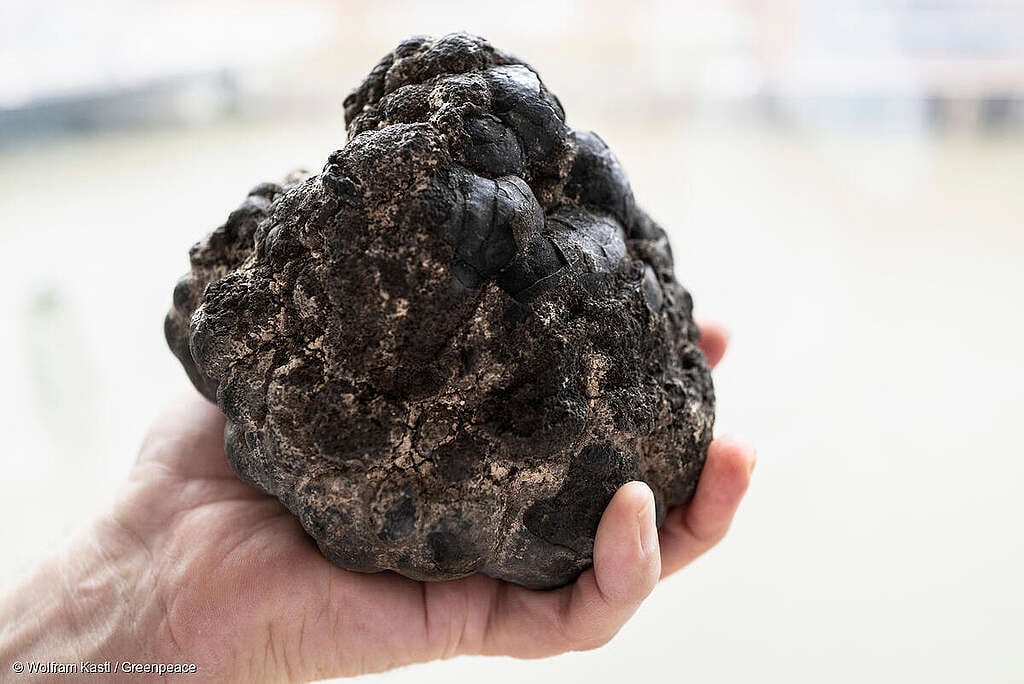
So, these little metallic lumps, which the wannabe deep sea miners have been metaphorically calling ‘batteries in a rock’ actually turned out to be just that – and they’re producing dark oxygen that could play a critical role in the deep ocean ecology.
The discovery of metallic nodules producing dark oxygen has been a huge surprise to science which could even require a new way of thinking about how life first began on planet Earth.
But it could also be the final straw in the case against deep sea mining. It could stop the industry before they begin.
The discovery was made in the Clarion-Clipperton Zone (CCZ), a huge flat area of the seafloor that stretches between Hawaii and Mexico, where mining companies like The Metals Company have plans to start harvesting these very same nodules that turn out to be producing all this dark oxygen.
These oxygen-producing nodules could be supporting a whole range of known and unknown deep sea lifeforms. Dark oxygen could be a critical factor in the deep sea ecosystem!
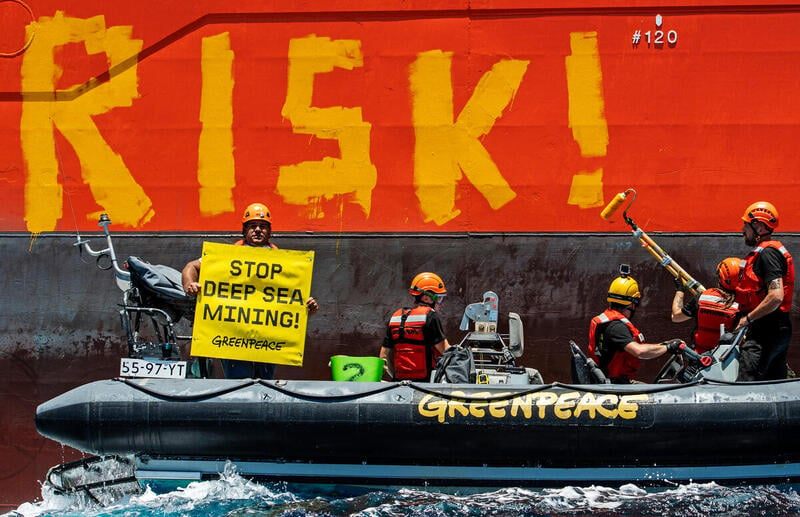
Greenpeace and others have long said that this new extractive mining industry should not be allowed to start in the very deep ocean because the life there is so little understood, and the ecosystems are fragile and potentially vital for the health of the ocean and all life on Earth.
This new discovery underlines the point.
The timing is good because world governments are meeting in Jamaica right now to decide the fate of this new mining industry. They’ll be deciding whether or not to allow deep sea miners like The Metals Company to go ahead with their plans to drop giant mining robots onto the seafloor to start harvesting these life-sustaining nodules.
Greenpeace is in Jamaica arguing strongly that deep sea mining should not be allowed to go ahead – especially now that we know the deep ocean is another source of oxygen that could be vital for the health of the ocean and all of us who depend on it.
In the climate and biodiversity crisis, we know that nature, in all its diversity, must be protected.

PETITION: Stop Deep Sea Mining
An emerging new industry could destroy this fragile and unique deep sea environment before we truly understand its importance.
Photo by Jong Marshes on Unsplash
For more information contact Deep Sea Defenders.
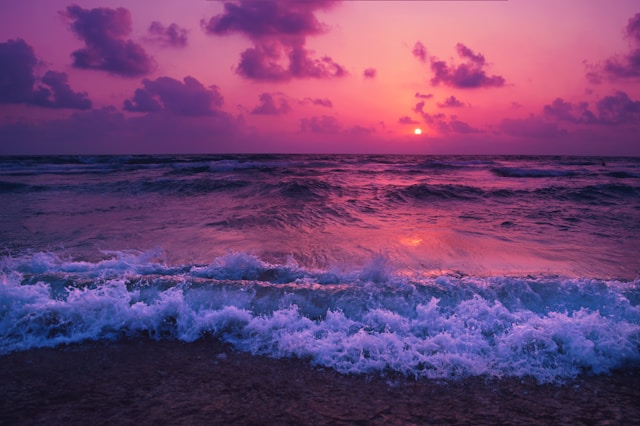
Editor’s note: Changing the face of a globalist, imperialist organization whose mandate is the equitable exploitation of “the common heritage of mankind” will not stop deep sea mining. We will need to stop the first attempt at enclosure and destruction of the sea floor, by any means necessary. Delegitimize, discredit and scuttle this operation. If you would like to help contact Deep Sea Defenders.
Brazilian oceanographer Leticia Carvalho will be the next secretary-general of the International Seabed Authority (ISA), the U.N.-mandated organization that oversees deep-sea mining activities in international waters. She won the election with 79 votes, while her predecessor, 64-year-old Michael Lodge, who served as the ISA’s secretary-general for two terms, received only 34 votes. Lodge has previously been accused of siding with mining companies, which went against the duty of the ISA secretariat to remain neutral and may have influenced the direction of the prospective deep-sea mining industry.
Carvalho previously told Mongabay that she would work to make the ISA more transparent and rebuild trust within the organization.
Brazilian oceanographer Leticia Carvalho has been named the next secretary-general of the International Seabed Authority (ISA) after winning an election that could change the course of the deep-sea mining industry.
Carvalho, 50, who currently works as an international civil servant for the United Nations Environment Programme (UNEP), was declared the winner of the race on Aug. 2, the last day of the twenty-ninth assembly meeting of the ISA. She won the election with 79 votes, while her predecessor, 64-year-old Michael Lodge, who served as the ISA’s secretary-general for two terms, received only 34 votes.
Carvalho will begin her term at the ISA, the U.N.-mandated organization that oversees deep-sea mining activities in international waters, in January 2025. She will be the first woman, the first oceanographer, and the first representative from Latin America to serve in this position.
Commercial-scale deep-sea mining has not yet begun anywhere in the world, but mining companies have been pushing for an imminent start of this activity — and Lodge has been accused of doing more than he should to help this process along.
During his time as secretary-general between 2016 and 2024, Lodge pushed for the finalization of a mining code, a set of rules that would allow deep-sea mining exploitation to begin. However, this code was not ultimately finished over his tenure. Lodge has also been accused of advocating for mining companies, which goes against the ISA secretariat’s duty of remaining neutral and keeping the ISA’s processes and procedures unnecessarily opaque. More recently, Lodge was also embroiled in allegations that he misused agency funds and that one of his supporters tried to bribe Carvalho to drop out of the election in exchange for another high-level position within the ISA. Lodge, however, has refuted all of these claims.
In a previous interview with Mongabay, Carvalho said that if elected, she would work to make the ISA more transparent and rebuild trust within the organization.
“For me, the mission of the ISA and the leadership of the ISA is to be a trustee — an honest broker that brings decision-makers together, offering space that belongs to the whole of humankind,” Carvalho told Mongabay in July. “It should offer transparency of its own procedures, on the decision-making processes, on the management of the budgets — all of this.”
One mining company, Canadian-based The Metals Company (TMC), has repeatedly expressed its intention to apply for an exploitation license later this year, even before the mining code is finished. However, Carvalho has said that she believes granting such a license before regulations are in place would be a “source of litigation.”
Advocates of deep-sea mining say seabed minerals are needed to fulfill metal shortages and provide materials for renewable energy technologies like electric car batteries. Yet critics say deep-sea minerals are unnecessary for such technologies and that deep-sea mining could irreparably damage the seabed and overall marine environment.
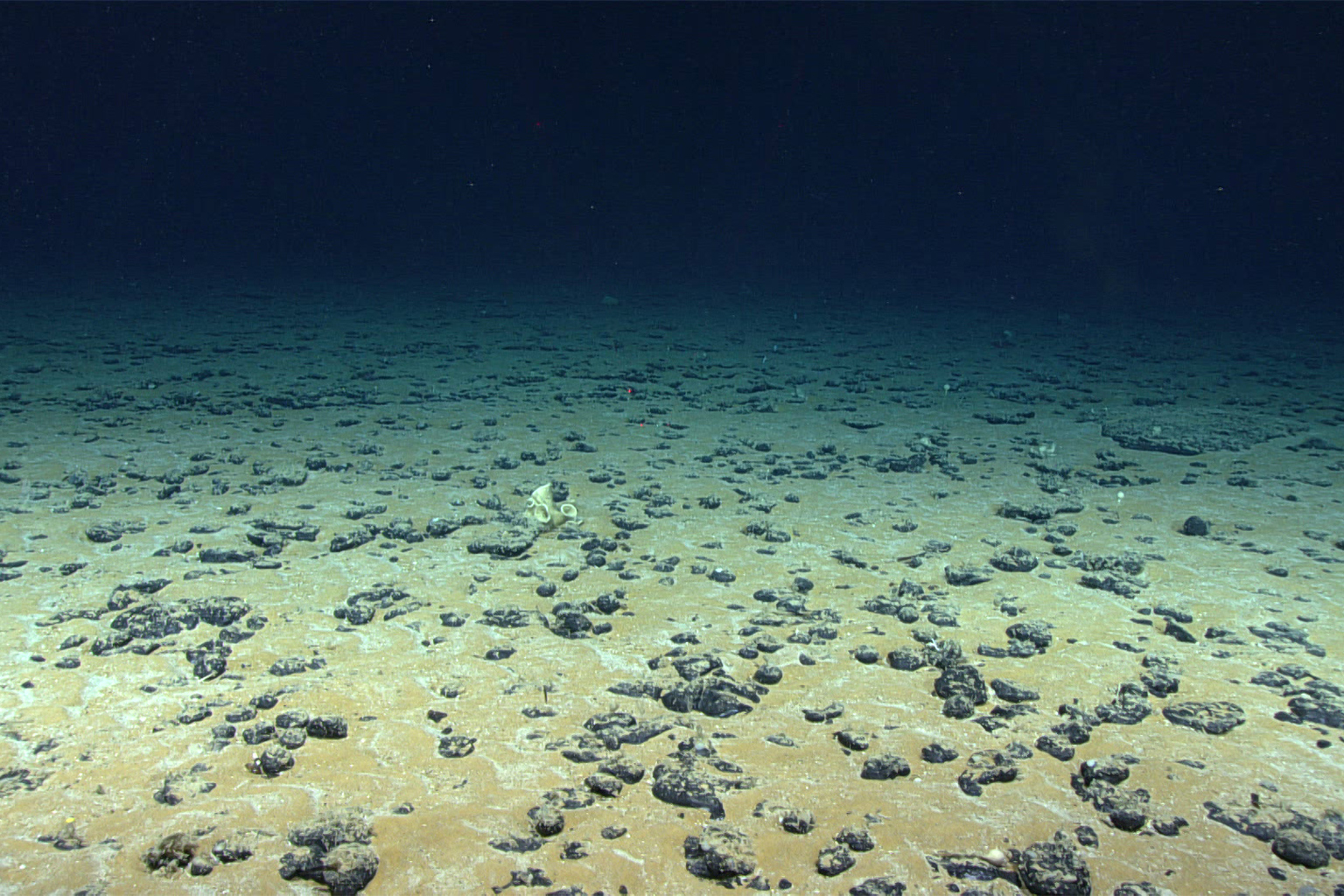
A recent study in Nature found that polymetallic nodules, metal-rich rocks found on the seafloor, produced a kind of “dark oxygen,” which experts say gives valid reason for slowing down the race to commercially extract nodules from the deep ocean.
During the recent ISA meetings, Austria, Guatemala, Honduras, Malta and Tuvalu joined a group of nations calling for a moratorium or precautionary pause on deep-sea mining. There are now 32 countries calling for such measures.
Matt Gianni, co-founder of the Deep Sea Conservation Coalition, a group of NGOs that campaign against deep-sea mining, said he was surprised by the number of country delegates that came to this year’s ISA meeting or sent in their proxy votes for the election, and also that “such a large majority” voted for Carvalho.
“This is a historic moment for the ISA and we congratulate Leticia Carvalho and the government of Brazil [for] her election,” Gianni said in a statement. “The ISA has an opportunity to champion a new way forward for sound ocean governance that prioritizes the precautionary principle and secures the health of the deep sea and its benefits for future generations.”
Elizabeth Claire Alberts is a senior staff writer for Mongabay’s Ocean Desk. Follow her on Twitter @ECAlberts.
Photo by Yousef Espanioly on Unsplash
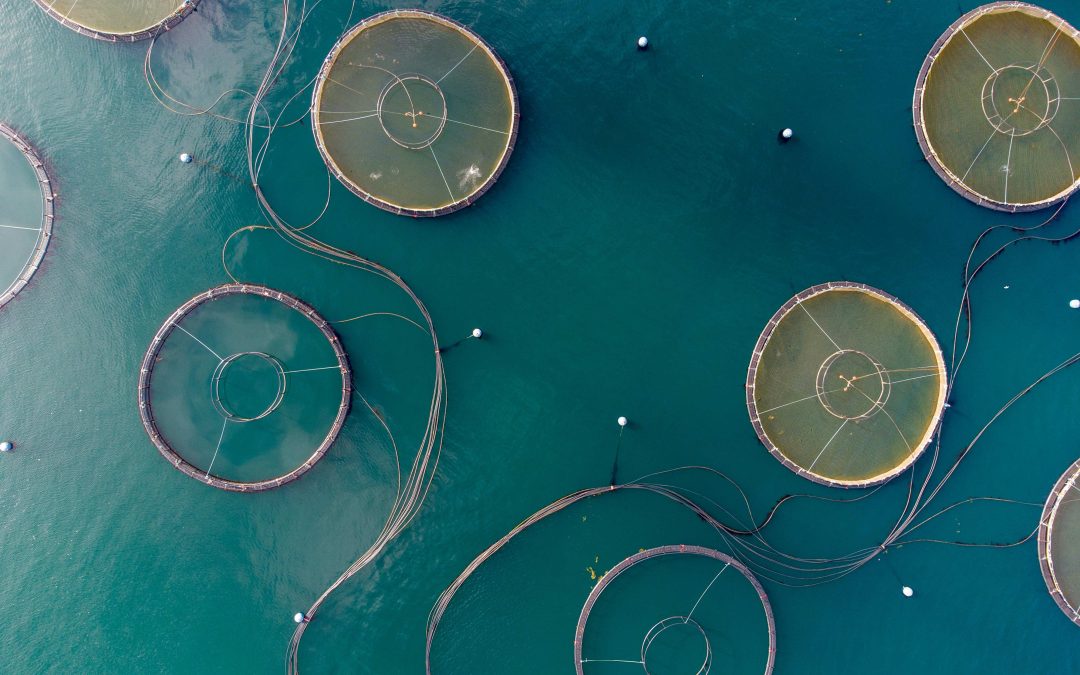
Editor’s Note: After exploiting almost every land on Earth, the industrial economy has now moved on to exploit the sea. Exploiters do not view the sea as many of us do: a deep body of water that is home to unimaginably large number of creatures. They see the sea as they view any other place on Earth: a huge reservoir of resources that might profit them. These profits come in many forms: greater wealth, which in turn is control over even more resources, and an ability to surround oneself with and have power over more people to do their bidding. It is for this that they are destroying life on Earth.
But, of course, that is not something they could publicly acknowledge. They have to create a more “righteous” justification for their not-so-righteous action. This is why they, in a cruel twist of words, claim to exploit the sea to protect the environment. In the following piece, Julia Barnes explains how the blue economy is just another form of greenwashing. Julia Barnes is the director of the award-winning documentaries Sea of Life and Bright Green Lies. She is a co-founder of Deep Sea Defenders, a campaign dedicated to protecting the marine environment from seabed mining. deepseadefenders.org
By Julia Barnes
The term “blue economy” was first introduced in 2012, at the United Nations climate change conference in Qatar, COP18.
It has become a buzzword used by ocean conservationists and industry alike. But what does this term actually mean? And more importantly, what are the implications for the ocean?
Definitions vary. For some, the term simply describes economic activities taking place at sea. However, most interpretations include language around sustainability, conservation, or better stewardship.
According to Google/Oxford Languages, the blue economy is defined as:
blue economy
noun
an economic system or sector that seeks to conserve marine and freshwater environments while using them in a sustainable way to develop economic growth and produce resources such as energy and food.
Embedded in this definition are the values and assumptions of the dominant culture: the idea that economic growth is desirable, that the ocean consists of resources to be exploited, and that these resources can be “developed” in a sustainable way.
Sustainable has become perhaps the most meaningless word in the English language. It has been pasted in front of nearly every destructive activity imaginable; used as a rhetorical shield to deflect criticism. We now have sustainable mining, sustainable forestry, sustainable fisheries, and sustainable energy. Yet, the real world effects of these activities remain the same: they are destroying the planet.
Some examples of sectors within the blue economy include: industrial fishing, aquaculture, shipping, coastal and marine tourism, energy (wind, waves, tidal, biofuel, offshore oil and gas), ocean-based carbon credits, mineral resources (deep sea mining, dredging, sand mining), and biotechnology (marine genetic resources, industrial enzymes) – all of which the ocean would be better off without.
The problem isn’t that these industries are being done in an unsustainable way and can somehow be tweaked to become sustainable; unsustainability is inherent to what they are, and to the economic model under which they operate – a model that demands infinite extractive growth despite the fact that our planet is finite and has already been largely denuded of life, a model that objectifies the ocean and values it only for the profit humans can extract from it.
The notion of a sustainable blue economy provides the illusion of protection. Meanwhile, industry and corporations are doubling down on their efforts to exploit the sea, extracting living organisms faster than the rate at which they can reproduce, destroying habitat, wiping out vulnerable species, and pushing new frontiers of extraction. Carbon capture schemes are popping up, abusing the sea in a shell game that legitimises continued emissions through supposed carbon “offsets”. Genetic prospecting threatens to privatize and commodify the very DNA of our nonhuman kin. Deep sea mining threatens to disrupt the ocean on a scale not previously seen. Offshore energy projects (for fossil fuels and so-called renewables) impose damage on the sea while providing power to the system that is at the root of the problem.
At a time when we should be pulling back, reducing our impact, and allowing the ocean to regenerate, the blue economy offers instead to continue business as usual, only rebranded.
As with so many of the things that have been marketed to us as “green”, the blue economy is primarily about sustaining a gluttonous way of life at the expense of life on the planet.
What if instead of defining the ocean as a resource, we valued it for what it really is? A living community vital to the functioning of our planet. The foundation of life on Earth. An entity with volition of its own. A force much older, larger, and wiser than we are. Something so powerful, beautiful, and magical, it cannot be described in words but can certainly be felt. Something sacred and deserving of respect.
The ocean is already collapsing under the many assaults of the global industrial economy. Further commodifying it under a vague claim of sustainability will not solve the problem.
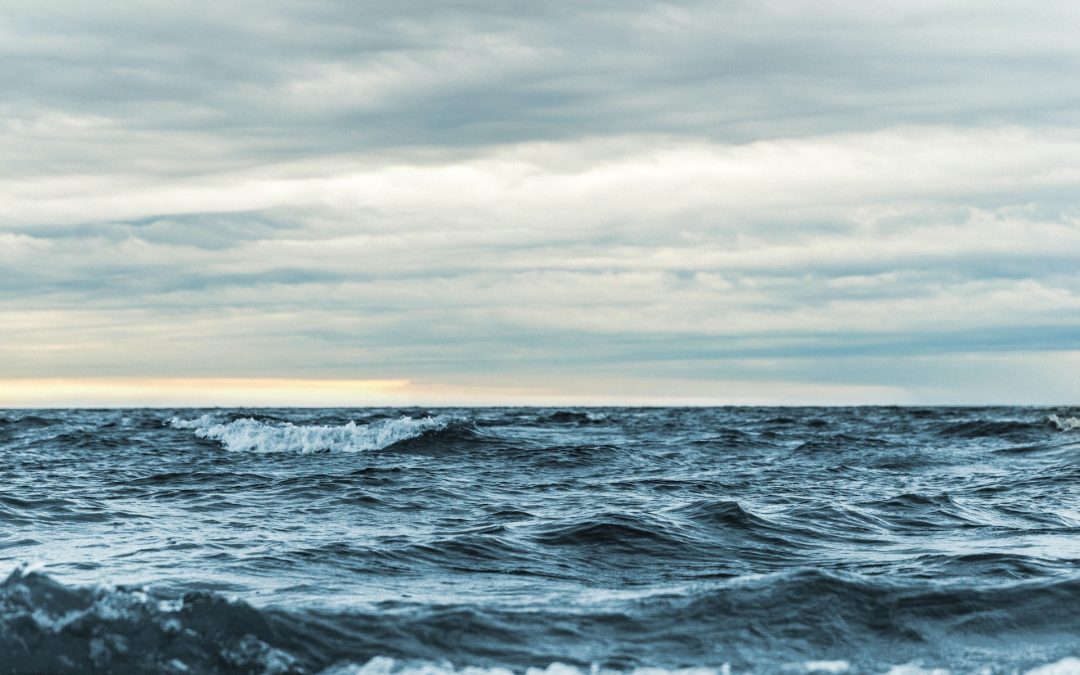
Editor’s Note: In this essay, Carl (one of our editors) describes the process of ocean acidification, and how it relates with other ecological crises.
By Carl van Warmerdam
First we need to know what an acid is. An acid is any substance (species) who’s molecules or ions are capable of donating a hydrogen ion proton (H+) to another substance in aqueous solution. The opposite of an acid is a base. Which is a substance who’s molecules or ions are able to accept a hydrogen ion from an acid. Acidic substances are usually identified by their sour taste while bases are bitter. The quantitative means to measure the degree to which a substance is acidic or basic is the detection of “potential of hydrogen” (pH) or “power of hydrogen”. This is expressed with a logarithmic scale 0 -14 that inversely indicates the activity of hydrogen ions in solution. The greater the amount of hydrogen ions which are measured below 7 the more acidic a substance is, going to 0. The less hydrogen ions are present which are measured above 7 the more basic a substance is, going to 14. So the pH values are inverse to number of hydrogen ions present. As the concentration of hydrogen ions increases the pH decreases (acidic). As the concentration of hydrogen ions decreases the pH increases (basic). With the value of 7 being neutral which is where pure distilled water falls on the scale. So acidification would be increasing hydrogen ions.
Basic (or alkaline) properties can be associated with the presence of hydroxide ions (OH−) in aqueous solution, and the neutralization of acids (H+) by bases can be explained in terms of the reaction of these two ions to give the neutral molecule water (H+ + OH− → H2O).
For millions of years the average pH of the ocean had maintained around 8.2, which is on the basic side of the scale. But since industrial development that number has dropped to slightly below 8.1. So not acidic but going in that direction. While this may not seem like a lot, remember the decrease is nonlinear and measures the amount of hydrogen ions present. A change in pH of 1 unit is equivalent to a tenfold change in the concentration of (H+) ions. So the drop of .11 units represents a 30% increase of (H+) ions than were present in the relative homeostasis state of preindustrial time. Ocean acidification is an increase in the dissolved hydrogen ions (H+) in the water.
Oceans absorb carbon dioxide (CO2) from the atmosphere through wave action. Pre-industrialization there was a balance between the CO2 going into the water and coming out of the water. The pH was stable in this narrow range. Life in the oceans have evolved to survive in a balanced condition. Industrialization through the burning of fossil fuel has released increased amounts of CO2 into the atmosphere. This has caused the oceans to absorb more CO2. So here is where the chemistry comes into play. As CO2 dissolves in water (H2O) the two create Hydroxycarboxylic (Carbonic) Acid (H2CO3).
CO2 + H2O = H2CO3
This breaks down easily into Hydrogen Carbonate ions (HCO3) and H+ ions.
H2CO3 = HCO3 + H+
Hydrogen ions break off of the Carbonic Acid. So more CO2 means more H+ ions which means increased acidity.
And this is where the problem is. Shells are formed primarily of Calcium Carbonate (CaCO3). But Carbonate (CO3) binds more easily with H+ than with Calcium (Ca), CO3 + 2H+. This takes away Carbonate that would have bonded with the Calcium for shell production. Calcium is relatively constant, so it is the concentration of carbonate that determines formation of calcium carbonate. Less carbonate available makes it more difficult for corals, mollusks, echinoderms, calcareous algae and other shelled organisms to form Calcium Carbonate (CaCO3), their major mineral building block. Also, when Carbonate concentrations fall too low, already formed CaCO3 starts to dissolve. So, marine organisms have a harder time making new shells and maintaining the ones they’ve already got. This causes decreased calcification. In healthy humans, normal body pH average is 7.4. This is one of the main reasons why the pH in swimming pools should be maintained around 7.5.
The acid-base balance of the oceans has been critical in maintaining the Earth’s habitability and allowing the emergence of early life.
“Scientists have long known that tiny marine organisms—phytoplankton(microscopic aquatic plants)—are central to cooling the world by emitting an organic compound known as dimethylsulphide (DMS). Acidification affects phytoplankton in the laboratory by lowering the pH (i.e. acidifying) in plankton-filled water tanks and measuring DMS emissions. When they set the ocean acidification levels for what is expected by 2100 (under a moderate greenhouse gas scenario) they found that cooling DMS emissions fell.”
Given the importance of plankton, the fact that they are the life-support system for the planet and humanity cannot survive without them, the resulting effects will be disastrous. These organisms produce 50% of the world’s oxygen – every other breath animals take and are the basis for the food web. Covering more than 70 percent of the earth’s surface the oceans, the planets lungs, are in peril.
“Over the past 200 years, the oceans have absorbed approximately half of the carbon dioxide (CO2) emitted by human activities, providing long-term carbon storage. Without this sink, the greenhouse gas concentration in the atmosphere would be much higher, and the planet much warmer.”
But absorbing the CO2 causes changes in ocean chemistry, namely lowering pH and decreasing carbonate (CO3) concentrations.
On a human time scale these changes have been slow and steady relative to that baseline. But on a geological time scale this change is more rapid than any change documented over the last 300 million years. So organisms that have evolved tolerance to a certain range of conditions may encounter increasingly stressful or even lethal conditions in the coming decades.
We know this through carbon dating of ice cores which offer scientists’ the best source for historical climate data. Also deep-sea sediment cores from the ocean floor are used to detail the Earth’s history.
Estimates of future carbon dioxide levels, based on business-as-usual emission scenarios, indicate that by the end of this century the surface waters of the ocean could have a pH around 7.8 The last time the ocean pH was that low was during the middle Miocene, 14-17 million years ago. The Earth was several degrees warmer and a major extinction event was occurring. Animals take millions of years to evolve. They go extinct without an adequate timeframe to adapt to changes in habitat. Ocean acidification is currently affecting the entire ocean, including coastal estuaries and waterways. Billions of people worldwide rely on food from the ocean as their primary source of protein. Many jobs and economies in the U.S. and around the world depend on the fish and shellfish that live in the ocean.
By absorbing increased carbon dioxide from the atmosphere, the ocean reduces the warming impact of these emissions if they were to have remained in the atmosphere. Shockingly, though, only 1 percent of that heat has ended up in the atmosphere nearly 90 percent of it, is going into the ocean. There, it’s setting ocean heat records year after year and driving increasingly severe marine heat waves. As the ocean temperature has risen its ability to absorb CO2 has decreased. Colder ocean water dissolves more CO2, absorbing more from the atmosphere. But we have steadily increased carbon emissions. The percent of current emissions produced sequestered into the oceans is thirty.
It is unknown if this uptake can be sustained. What might happen to the Earth’s atmosphere if the ocean is unable to absorb continued increased carbon dioxide?
“If the seas are warmer than usual, you can expect higher air temperatures too, says Tim Lenton, professor of climate change at Exeter University. Most of the extra heat trapped by the build-up of greenhouse gases has gone into warming the surface ocean, he explains. That extra heat tends to get mixed downwards towards the deeper ocean, but movements in oceans currents – like El Niño – can bring it back to the surface.”
The ocean surface favors mineral formation, in deeper waters it dissolves.
So it is obvious industrializing the oceans with offshore wind farms and deep sea mining, what capitalism calls the Blue Economy, will have the effect of continued acidification. But it will cause even more ramifications because it will have a direct impact on the species that live there and in the habitat where “raw” materials are extracted.
Regions of the ocean where the plankton communities are more efficiently utilizing organic matter, such as the deep sea, are places where the ocean has a naturally lower capacity to absorb some of the carbon dioxide produced by humans. “So understanding how zooplankton(small aquatic animals) communities process carbon, which, to them, represents food and energy, helps us to understand the role of the ocean in absorbing carbon dioxide in the atmosphere,” – Conner Shea doctoral student in the UH Mānoa School of Ocean and Earth Science and Technology (SOEST) Department of Oceanography.
We are headed for a Blue Ocean Event by 2030 – that is for the first time since ancient humans started roaming Earth several million years ago, an ice-free Arctic Ocean in the summer. The water instead of ice will be absorbing the suns heat rather than reflexing it back. Thus increasing sea temperature rise and disruption of the jet stream. This is basically what solar panels and wind turbines do. They make the earth hotter. Wind turbines extract the cooling breezes for their energy, the opposite of a fan. Miles and miles of solar panels destroy habitat and absorb the heat.
Continued industrialization will have the devastating effect of threats to food supplies, loss of coastal protection, diminished biodiversity and disruption of the carbon cycling – arising from these chemical reactions. This story involves a fundamental change within the largest living space on the planet, changes that are happening fast, and right now.
The oceans will find a new balance hundreds of thousands of years from now but between now and then marine organisms and environments will suffer.
The earth’s temperature cycles, glacial – interglacial, are primarily driven by periodic changes in the Earth’s orbit. Three distinct orbital cycles – called Milankovitch cycles. A Serbian scientist calculated that Ice Ages occur approximately every 41,000 years. Subsequent research confirms that they did occur at 41,000-year intervals between one and three million years ago. But about 800,000 years ago, the cycle of Ice Ages lengthened to 100,000 years, matching Earth’s deviation of orbit from her circularity cycle. While various theories have been proposed to explain this transition, scientists do not yet have a clear answer. So CO2 historically has not caused climate change, it’s increased in the atmosphere during warmer temperatures and decreased during colder temperatures. Feedback loops have amplified changes initiated by orbital variations. But it is now humans that are currently increasing the amount of CO2 in the atmosphere by burning fossil fuels.
Strictly from an anthropocentric point of view, humanity could adapt to global warming and extreme weather changes. It will not survive the extinction of most marine plants and animals. The destruction of nature is more dangerous than climate change. It is sad that in the effort to save the climate and continuance of business as usual, we are destroying the environment. All of life came from the sea, it would be unwise to harm the birthplace of all species.
Photo by Ant Rozetsky on Unsplash
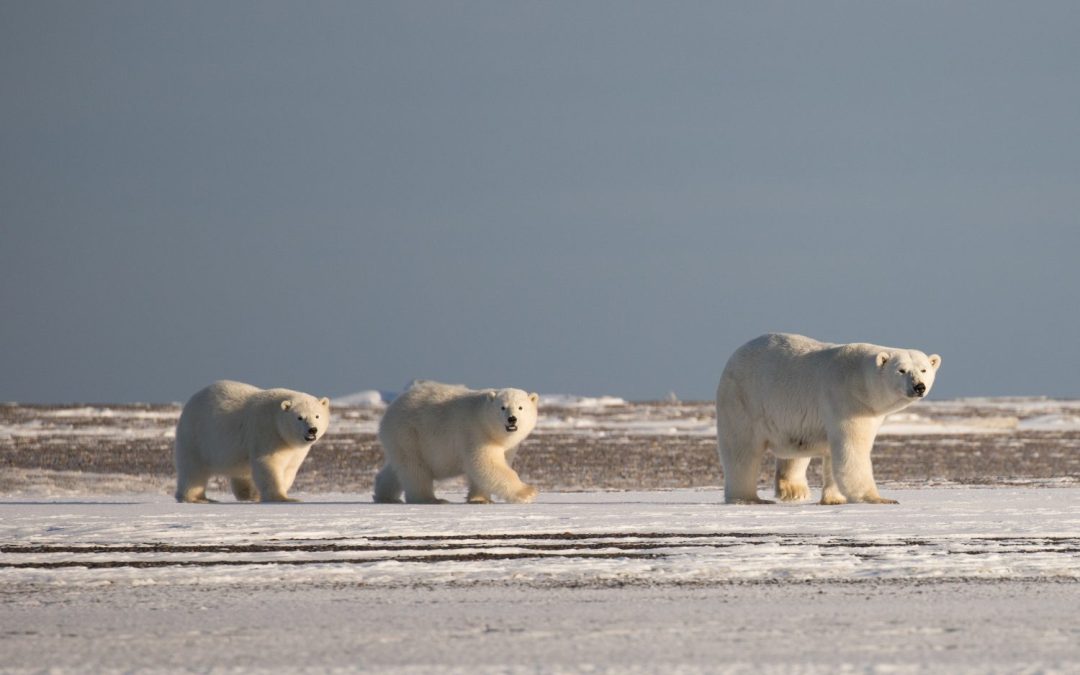
Editor’s Note: In the Fight for Who We Love series, we introduce you to a species. These nonhuman species are what inspires most of us to join environmental movements and to continue to fight for the natural world. We hope you find this series inspiring, informative, and a break from news on industrial civilization. Let us know what you think in the comments! Also, if there is a species that you want us to cover in the upcoming months, please make suggestions. Today they are polar bears.
By Kim Olson and Benja Weller
When there’s talk about climate change affecting other species, people often think of polar bears. Because yes, their habitat is being destroyed — and we’ll get to that.
But the reason we’re writing about polar bears today is because long before I (Kim) knew anything about climate change or melting ice caps, they were my favorite wild animal. Because to me, they represent patience and intelligence, strength and resilience, playfulness and beauty.

A polar bear stretches in Kaktovik, Alaska. Photo: Kim Olson
Like much of the wild world (what’s left), polar bears must put in some serious effort and time to acquire their next meal, and as the largest terrestrial carnivorous mammal on earth, that’s no small amount.
“Polar bears need to consume approximately 4.4lbs [2kg] of fat daily or a 121lbs [55kg] seal provides about 8 days’ worth of energy. Polar bears can eat 100lbs [45kg] of seal blubber in one sitting.”
A typical polar bear meal doesn’t vary a whole lot and includes one main course: seals (ringed, but also bearded, hooded and harped). But when food is scarce, they’re opportunistic eaters and will munch on berries, fish, plants, birds, small mammals — basically whatever they can find, which unfortunately also includes human garbage.
While polar bears use their semi-webbed, big-ass paws (about 12in / 30cm, which is bigger than most human heads!) to wander the snowy ground and doggy paddle around the Arctic Ocean like nobody’s business, they aren’t aquatic animals. So they have to hunt usually at the edge of sea ice or next to a seal’s breathing hole.
Once the bears locate a suitable place to hunt, they get comfortable and prepare themselves for a potentially long wait. This most common “still-hunting” method, which they’re the most successful at, requires that the bears barely move for hours and sometimes even days.
Days! I don’t know about you, but I find that kind of commitment and patience remarkable. Because in an age where instant gratification is a thing, us civilized humans may sometimes feel it’s unbearable to have to wait longer than even thirty minutes for a meal when we’re hungry. But polar bears? They’ve got the patience thing down. I mean, they have to. Because, contrary to popular belief, food doesn’t actually come from the grocery store.
When not about to pounce on a seal, polar bears are generally slow-moving creatures, ambling leisurely and deliberately to conserve their strength. At times they may wander for miles, their huge paws helping to keep them from sinking too deeply into the snow.
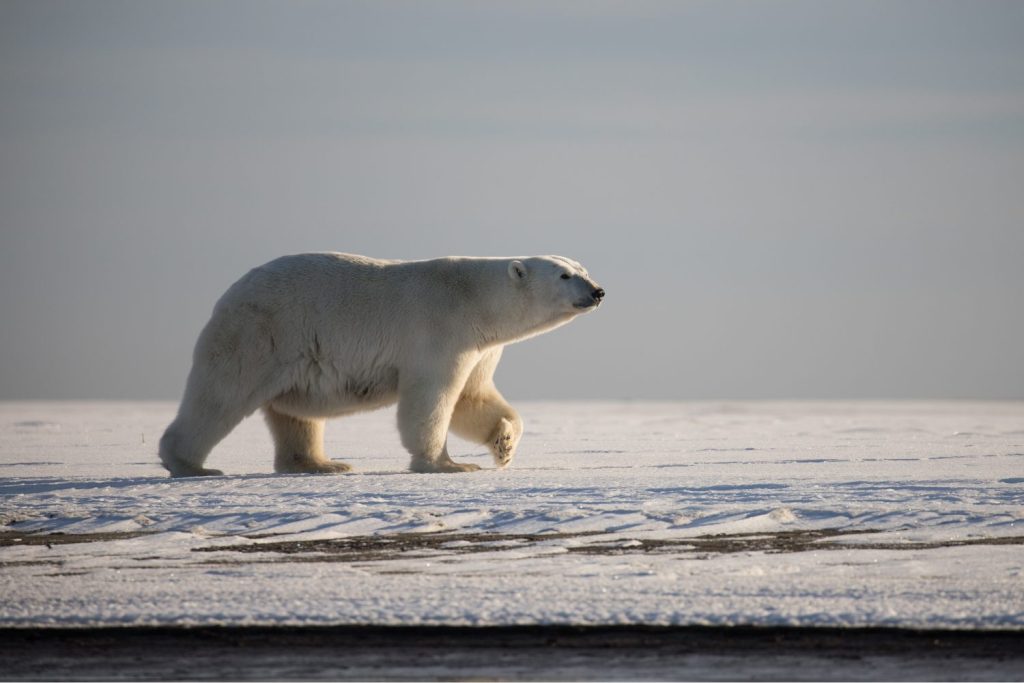
A bear walks across the snowy ground in Kaktovik, Alaska. Photo: Kim Olson
Polar bears diverged from brown bears but it’s not clear when — some estimates say a few hundred thousand years while newer guesses put it at a few million years.
But no matter when the split occurred, polar bears developed some unique characteristics that help them survive in a harsh climate where average winter temperatures are around -29°F / -2°C.
Most bears live north of the Arctic Circle in the US, Canada, Greenland, Norway, and Russia, and spend much of their lives on sea ice hunting (some sources say up to 50% of their time).
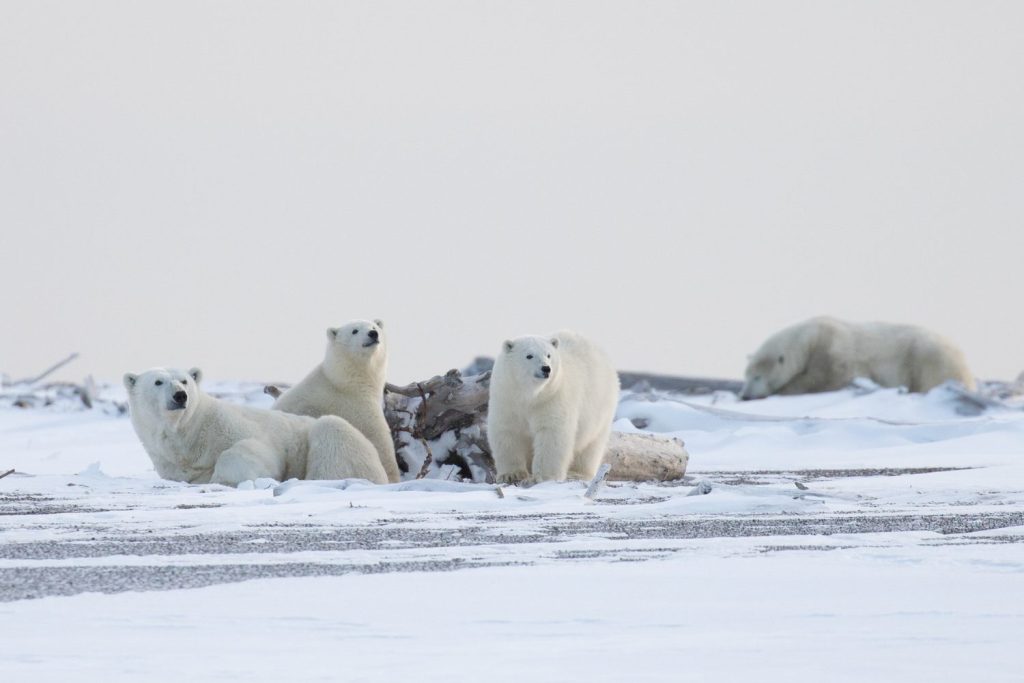
A mama bear with her two cubs in Kaktovik, Alaska. Photo: Kim Olson
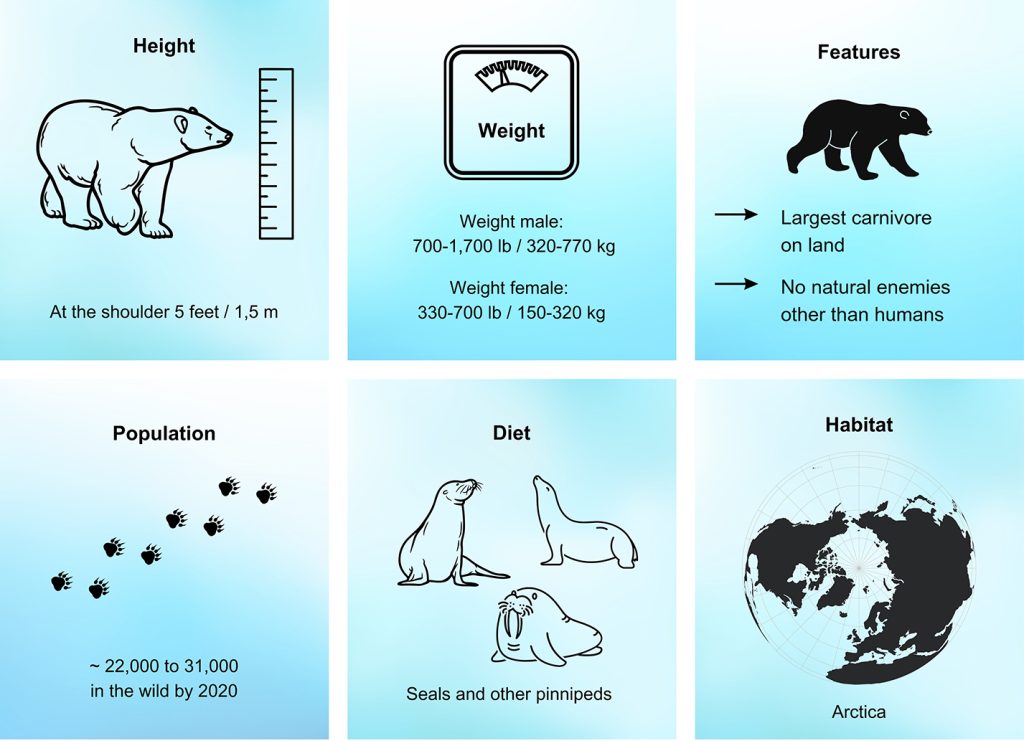
Infographic by Benja Weller CC-BY-NC-ND 4.0
Size: Males are about 2-3 times larger than females.
Length: 6-8′ [1.8-2.4m] females, 8-10′ [2.4-3m] males, 12″ [.3m] newborn
Height: up to 5′ [1.5m] at shoulder on all four paws, 7-11′ [3.3m] standing upright
Weight: 300-700lb [136-318kg] females, 700-1700lb [318-771kg] male, 1-1.5lb [.5-.7kg] newborn
Paws: webbed paws up to ~12” [30cm] across, which makes them good paddles
Lifespan: 20-30 years in the wild
Running Speed: 25mph [40kph]
Swimming Speed: 6mph [10kph] for up to 62mi [100km] continuously
Walking Speed: 3.4mph [5.5kph]
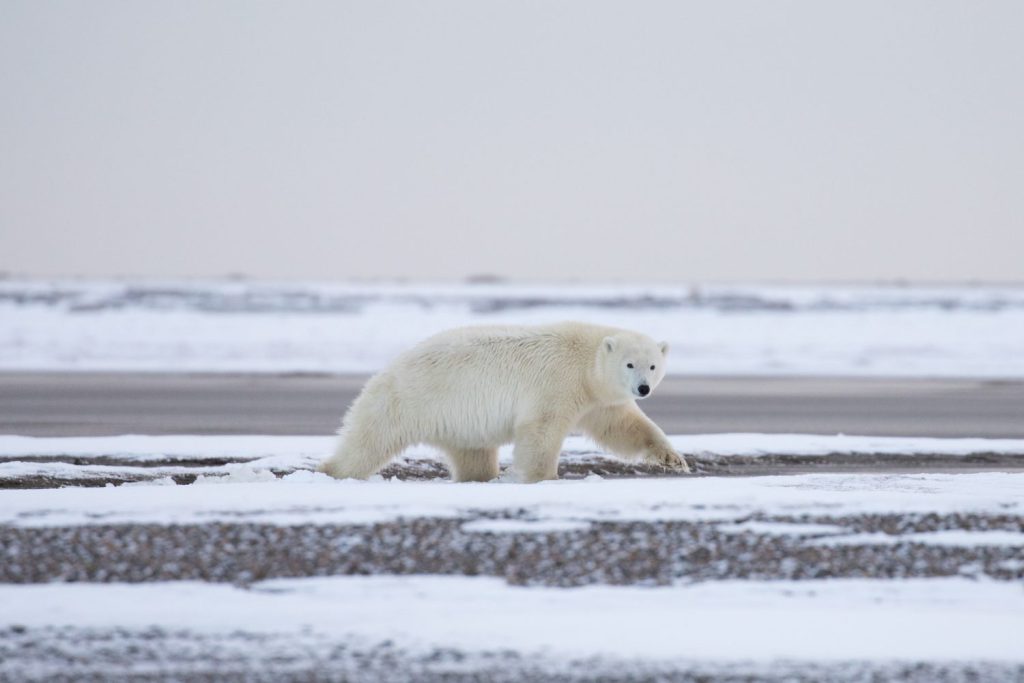
A solo polar bear walking in Kaktovik, Alaska. Photo: Kim Olson
Most of us have seen pictures or videos of starving polar bears in the news. Skinny polar bears searching for food or sitting on an ice sheet with nothing around them but water are heart-wrenching to watch.
Photos and videos like those show the devastating effects of global warming, and are warning signs that express the conclusion in a BBC article by Helen Briggs and Victoria Grill: “Polar bears will be wiped out by the end of the century unless more is done to tackle climate change, a study (by Nature Climate Change) predicts.“
The single most important threat to the long-term survival of polar bears is loss of sea ice due to global warming, according to the International Union for Conservation of Nature. National Geographic writes about the bears in the Beaufort Sea region, who are among the best studied: “Their numbers have fallen 40 percent in the last ten years.”
In our times of warmer climate, sea ice melts earlier in the spring and forms later in the autumn, forcing polar bears to walk or swim longer distances to the remaining ice sheets.
The second effect of melting sea ice is that the bears stay on land longer fasting and living off their fat stores. In both cases, the extra energy loss affects their ability to effectively reproduce and raise babies. When the mother is too skinny, a couple of problems arise:
Initially she can’t have as many babies as a healthy mom can. But when she does have cubs, they have a greater risk of dying by starvation due to the lack of fat in the mother’s milk. This can only mean that the entire population of polar bears decline.
Pollution and the exploration of new oil and gas resources are also major threats to these white predators. As we’ve outlined in the article about Adélie penguins, there’s persistent organic pollutants (POPs) being moved from warmer areas to the cold Antarctic and Arctic.
If bears eat seals, they also consume POPs, and high levels of POPs rob polar bears of their vitamin A, thyroid hormones, and some antibodies which impairs their growth, reproduction, and the strength to fight off diseases.
As easy-to-access oil and gas resources become scarcer, the industries explore in the most remote places to find this so-called “black gold.” Unhinged, they try to exploit the beautiful Arctic, even though offshore oil operations pose a great risk to the polar bears.
When oil spills into the sea, it affects the bear’s fur, reducing its insulating effect. The bears unknowingly ingest the oil which can cause long-term liver and kidney damage, even if it’s a small amount. Oil spills can wipe out entire populations when they happen in places where there’s a high density of polar bear dens.
Despite sitting around most of the time, National Geographic says that these high-energy beasts can burn through 12,325 calories a day, which is equivalent to 40 (!) burgers.
The polar bears can’t just adapt to melting ice sheets and change their hunting methods in an instant — evolution doesn’t work like that.

Two polar bears play fight in Kaktovik, Alaska. Photo: Kim Olson
If you ask us, a world without the magnificent polar bears is a world worse off. So they are one more reason #whywefight.
Featured Image: A female polar bear with her two cubs in Kaktovik, Alaska. Photo: Kim Olson
The 2023 DGR conference is scheduled for late August in northern California. This annual gathering is an opportunity for our community to share skills, reflect on our work, strengthen our connections, and plan for the future. While this conference is only open to DGR members, we do invite friends and allies on a case-by-case basis. If you’re interested in attending, please contact us, and if you’d like to donate to support the conference, click here.